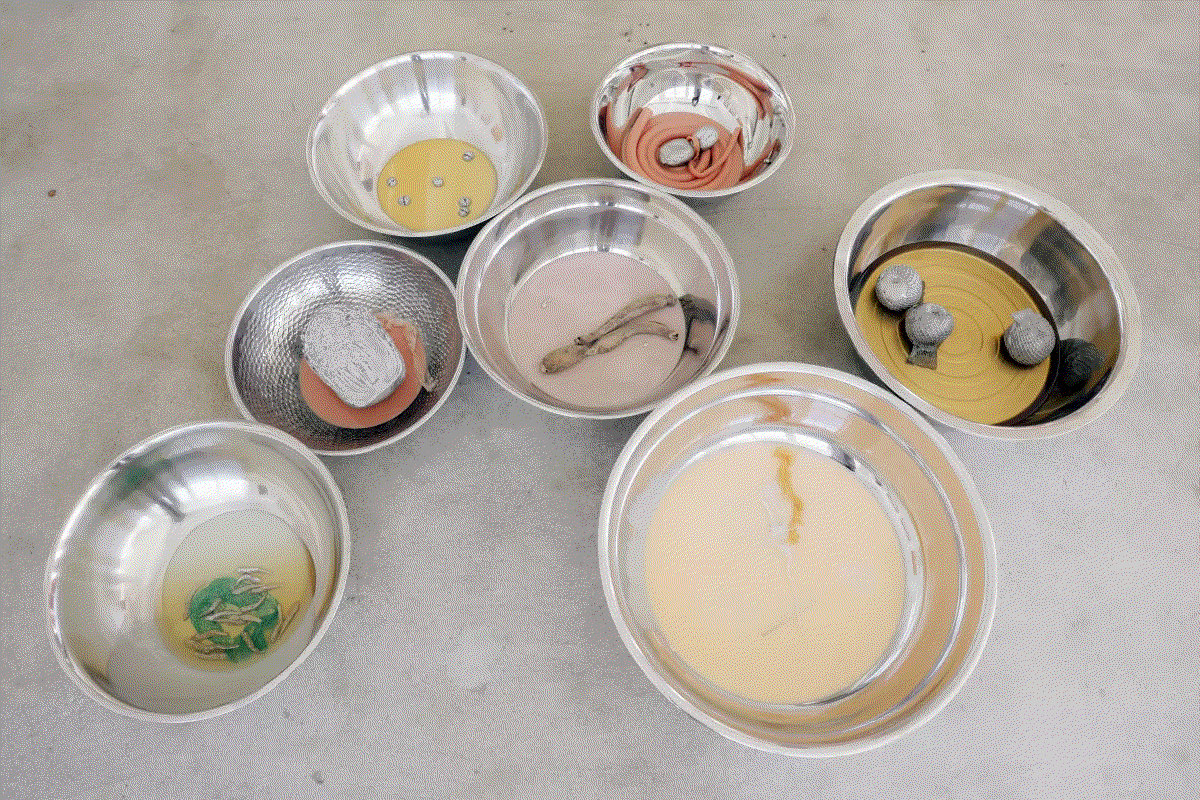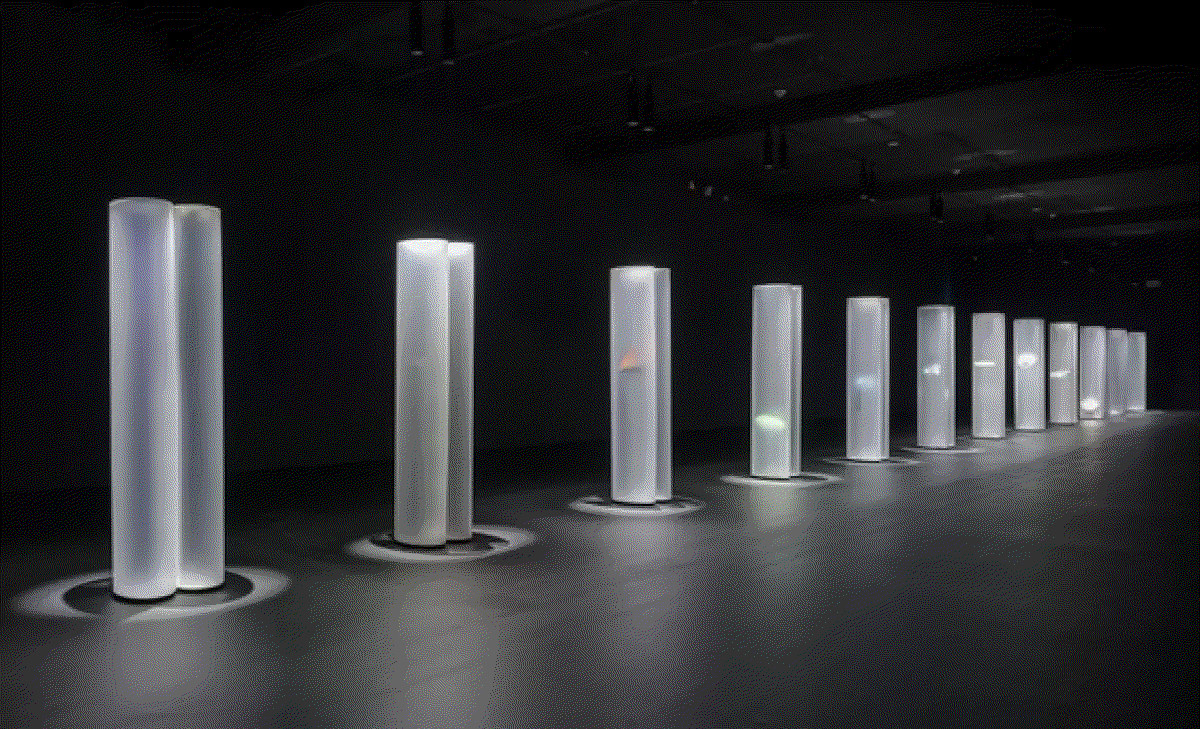
The thing about being an arts writer is: You get to look at art for a living. And mull it for days.
The thing about being an arts writer is: Days of mulling can turn into weeks or months. Or even a year.
Not to say that this is a bad thing. But sometimes — call it an occupational hazard or free perk, depending — an individual art piece or body of work gets seeded in my brain, its image or soundscape or visceral feeling hovering in my consciousness and commanding attention at the most unexpected times. Like the video snippet of a desperate, shrieking woman embedded in the cement floor of MOCA’s Geffen Contemporary — more on that later, but suffice to say her crooning, in Italian, rang in my head for weeks while I shopped for groceries or pumped gas.
Here are five artworks that wormed their way into my head this year — and stayed there for inordinate lengths of time.
Trenton Doyle Hancock’s ‘The Skint Alterpiece: Vegans Make Deposits at the Tofu Bank’ at Shulamit Nazarian

Trenton Doyle Hancock’s “The Skint Alterpiece: Vegans Make Deposits at the Tofu Bank,” 2020. (From the artist and Shulamit Nazarian, Los Angeles)
How can you look away from a massive canvas depicting a society of pale, emaciated-looking vegans processing tofu in fantastical-looking factories while working to rid the universe of half-animal, half-plant characters? I couldn’t. Hancock’s “The Skint Alterpiece: Vegans Make Deposits at the Tofu Bank” was part of his solo exhibition, “Good Grief, Bad Grief,” at Shulamit Nazarian this fall. The show drew from his repertoire of superhero-villain characters while also exploring race, class, identity and power dynamics in America. The 6-foot-tall, 9-foot-wide “Skint Alterpiece” drew from the Houston-based artist’s epic graphic novel in progress. The stark, textured piece — dense to the point of dizzying — includes hundreds of collaged, black-and-white ink drawings, accentuated by tufts of faux fur, bottle caps and painted accents. I dreamed about the painting the first night I saw it and bits of the work factored into additional dreams — the maze-like, intricate line drawings and affixed objects whirring, popping and clicking, like the interior workings of a clock, throughout the night — though the ending of the dream was different every time.
Laurie Kang’s‘Mother’ at Horizon Art Foundation

Laurie Kang’s installation “Mother.” (Dania Maxwell / Los Angeles Times)
“Blood, sweat and snot — and Dior Backstage Eyeshadow Palette in neutral tones.” That’s how I described the work-in-progress that I saw in Kang’s studio in April, pieces created as part of Horizon Art Foundation’s inaugural artist residency. And yet, Kang’s installation of cast aluminum food items “floating” in bowls of tinted liquid (actually silicone) were curiously appetizing. I wanted to eat them — or purge them. Both. Sure, the pile of silvery chestnuts floating in one bowl looked like tiny brains; the rotund Asian pears looked organ-like; a cast-silicone tube, coiled around a lotus tuber, looked like a human umbilical cord (OK, I didn’t want to eat that). But the textures and colors were so pretty and palatable — translucent and lustrous-looking, in hues of nude, cream, gray and peach — that they sparked conflicting urges. Kang’s work draws on her Korean heritage and addresses issues of identity as well as the changing human body. But it was these primal contradictions in “Mother” that I went on about at dinner parties for months afterward.
Madeline Hollander: Sunrise/Sunset’ at Jeffrey Deitch

“Madeline Hollander: Sunrise/Sunset.”(Joshua White )
Deitch opened a second gallery in the former LAXArt building on Santa Monica Boulevard in September. L.A. artist Hollander’s live, sculptural sound installation inaugurated the new space, taking over the first floor. The work is composed of 96 recycled car headlights, and their glaring LEDs blink on and off, moving across the wall in accordance with the rhythms of the sun. Individual columns of headlights are synced to different time zones around the world. The work includes an original score by L.A.-based composer Celia Hollander, the artist’s sister, made from recorded automobile turn signals. It evokes a chorus of hollow-sounding leaky pipes or the steady plip-plop of raindrops on a windshield. The result is a fluid, meditative piece that’s simultaneously high tech and organic-feeling, a multimedia work that feels very much of the earth. And very, very of Los Angeles.
“Helen Pashgian: Light Invisible” at LACMA — and in memory

“Helen Pashgian: Light Invisible” at LACMA in 2014. (Art by Helen Pashgian; photo from Museum Associates/LACMA)
I first met Pashgian, a pioneer of the ‘60s and ‘70s Light and Space movement, in 2014, when profiling her prior to the opening of her major Los Angeles County Museum of Art exhibition that year. I watched her work in her Pasadena studio, sanding and sculpting the 12 towering acrylic columns in “Helen Pashgian: Light Invisible.” I described the installation, at the time, as “elegant and austere, dramatic and sensual” — and mysterious, like Pashgian herself. I loved the work, but soon moved on. Then I reconnected with Pashgian at this year’s LACMA gala, which was honoring the artist. That night, after the gala, I Googled images of “Light Invisible” to remind myself; I reread how they’d been made, using an intricate process of interior clamps and glue. And a new, almost raging appreciation surfaced for the work — particularly for those luminescent, ever-morphing interior shapes and shadows — that I haven’t been able to shake since. Pashgian is making new work that will debut at LACMA this spring, and I can’t wait to see it.
Pipilotti Rist’s ‘Selbstlos im Lavabad’ (Selfless in the Bath of Lava) at the Geffen Contemporary at MOCA

Installation view of “Selbstlos im Lavabad,” here nestled between shoes for scale, at the Geffen Contemporary at MOCA. (Zak Kelley / Museum of Contemporary Art)
I missed this artwork the first time I visited “Pipilotti Rist: Big Heartedness, Be My Neighbor” at the Geffen Contemporary at MOCA this year. I literally walked right over it. Then on my second visit, I was mesmerized. A small, maybe silver-dollar-sized hole was in the concrete floor, beneath which a video snippet showed the artist playing a character who was nude and flailing her arms, trapped in scorching lava. She glared up at the opening in the floor, shrieking in Italian, German, French and English: “I am a worm and you are a flower! You would have done everything better. Help me!” The six-minute, 20-second piece, which played on a loop, was so tiny and seemingly inconsequential, dwarfed by the enormous surrounding installations, a prism of blinking lights and vibrant color. But it was this itty-bitty video, embedded in the floor, that stuck with me — for better or worse. Try pumping gas with a lava-ensconced artist screaming in four languages in your ear.

